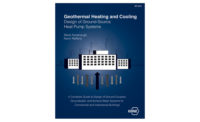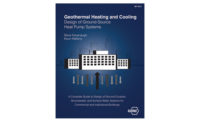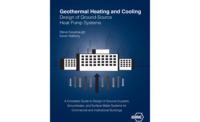A new track added to the Technical Program at ASHRAE’s 2014 Annual Conference, which takes place June 28-July 2 in Seattle, speaks to the challenges engineers face when designing ground-source heat pumps as compared to more traditional systems.
The Technical Program kicks off June 29, with interactive programs and a networking coffee break, and concludes July 2. The program addresses broad topics in the application of technology to practice, specific applications in ground-source heat pumps, operations and maintenance, and indoor environmental quality, as well as new reports on research taking place worldwide.
The “Ground Source Heat Pumps State of the Art: Design, Performance and Research” track addresses all aspects of design that lead to optimally performing systems while avoiding common pitfalls that lead to poorly performing systems. The track was organized by ASHRAE, the National Ground Water Association, the International Ground Source Heat Pump Association and the Geothermal Exchange Organization.
“There are a number of challenges that engineers face that are different from conventional HVAC systems, such as ground coupling, working with drillers, and the importance of annual heating and cooling loads to ground heat exchanger design,” said Jeff Spitler, an ASHRAE member who helped create the track. “This track addresses the entire design and installation process from site evaluation to commissioning and system operation. In addition, GSHP systems are inherently energy efficient, but poor choices in the design can compromise this inherent efficiency. What not to do is also addressed in the track.”
Spitler added that organizers have drawn in researchers from around the world to discuss new advances in the field so attendees have the opportunity to hear about the latest research and state-of-the-art design practice.
“We want to help practicing engineers understand where the industry began, where it stands currently (what tools and design guides are available) and where it is headed (through the programs showcasing current research),” said Lisa Meline, recent chair of ASHRAE’s technical committee 6.8, Geothermal Heat Pump and Energy Recovery Applications. “We also hope to impart guidance to the practicing engineers on the ground heat exchanger portion of a ground-source design. Many engineers shy away from this type of design because they don’t understand it. We want to change that and reinforce the need to provide single-point-of responsibility for all different types of HVAC system designs.”
Sessions in the track are:
June 29
• Step 1: Assessing a Project Site for Geothermal Heat Pump Applications
• Ground Source Heat Pump System Performance Case Studies in Different Climates Around the World
• GEO 2.0: From the Ground Up, an Overview of the Updated ASHRAE GSHP ‘Blue Book’
• Ground Source Heat Pump System Case Studies
June 30
• Geothermal Heat Pump Track Keynote Presentation
• Documentation and Contract Administration in Tendered and Design/Build Ground-Coupled Heat Pump Projects
• Ground Source Heat Pumps: Historical Perspective and Track Overview
July 1
• Monitoring of Ground Source Heat Pump Systems
What the Well?
• New Developments in Simulation and Modeling of Ground Heat Exchangers
July 2
• Ground Source Systems Commissioning and Closeout: Unique Issues, Avoiding Fatal Flaws and Ensuring Client Satisfaction
• Central Plant GCHP Systems
• Optimization of Ground Coupled Heat Exchangers and Heat Pumps
The Conference takes place at the Sheraton Seattle and the Washington State Convention Center. To register or for more information, visit www.ashrae.org/seattle.



